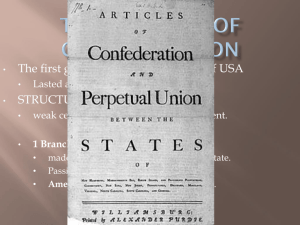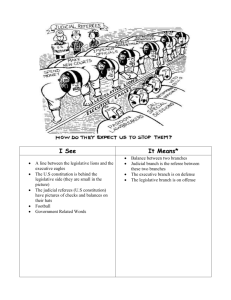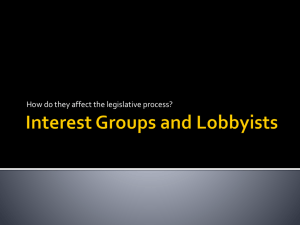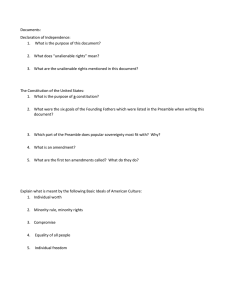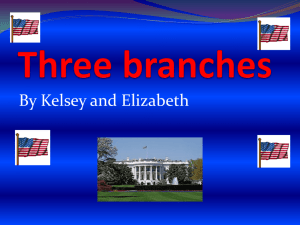Litigation versus Legislation: Forum Shopping by Rent-Seekers
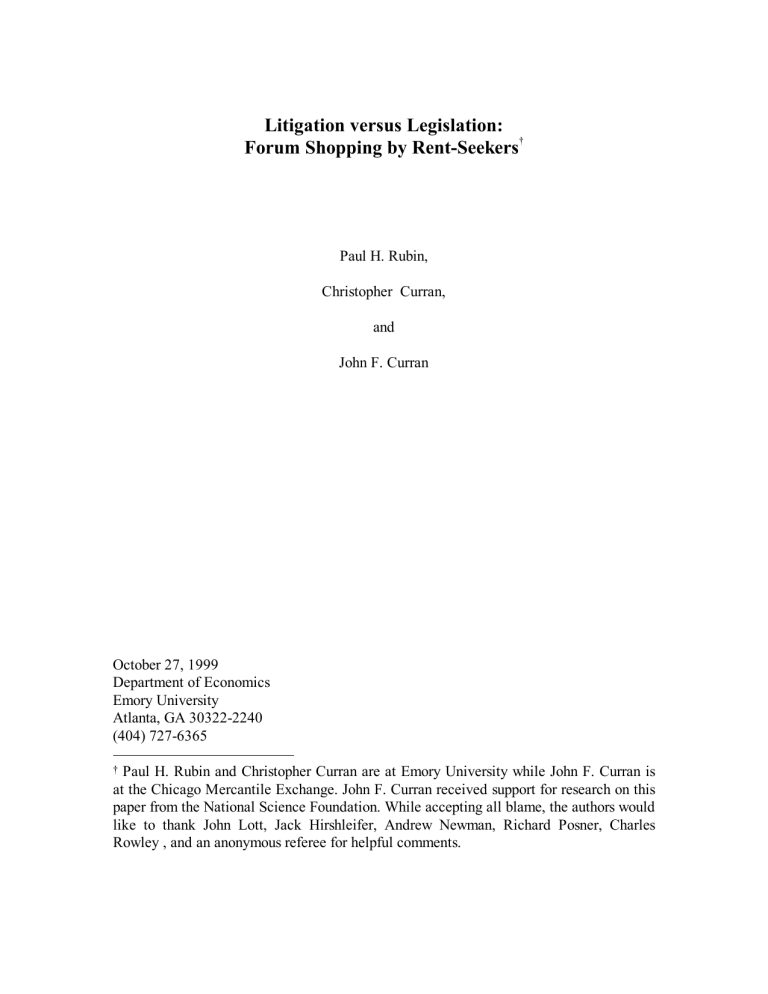
Litigation versus Legislation:
Forum Shopping by Rent-Seekers
†
Paul H. Rubin,
Christopher Curran, and
John F. Curran
October 27, 1999
Department of Economics
Emory University
Atlanta, GA 30322-2240
(404) 727-6365
† Paul H. Rubin and Christopher Curran are at Emory University while John F. Curran is at the Chicago Mercantile Exchange. John F. Curran received support for research on this paper from the National Science Foundation. While accepting all blame, the authors would like to thank John Lott, Jack Hirshleifer, Andrew Newman, Richard Posner, Charles
Rowley , and an anonymous referee for helpful comments.
Abstract
To change the law, an interest group must choose between lobbying the legislature and litigating for new precedent. Lobbying becomes more likely as the relative benefits from rule change become greater, as the costs of lobbying become smaller and as the voting strength of the interest groups becomes larger. Litigating becomes more likely as trial costs fall, as the relative benefits from rule change become greater, as the inclination of courts to change existing precedents increases, and as the interest group is involved in more trials. Examples of using a litigating strategy include the NAACP is its battle for racial integration and attorneys seeking change in tort law. Business, in resisting changes to tort law, has used the judicial process. The nature of equilibrium, if any, is not clear.
Keywords: interest groups, lobbying, litigation, racial integration, tort law
-2-
I. INTRODUCTION
Economists treat public law and private law very differently. Public choice analysis shows that much public law is inefficient and aimed at rent seeking. On the other hand, private law is often viewed as efficient (see, for example, Posner, 1992; Priest, 1977; and
Rubin, 1977). Even when private law is viewed as being inefficient, there are few theories as to the source of such law. Standard legal analysis views the law as the result of attempts
(sometimes misguided) of judges to achieve desirable goals. With relatively few exceptions
(see, for example, Rubin and Bailey, 1994, and Farmer and Pecorino, 1999), students of law and economics do not view private law from an interest group perspective. In this paper, we argue that interest groups can sometimes use the common law litigation process for benefit seeking. We provide a model of the decision by an interest group as to whether to use the litigation process or traditional lobbying for the purpose of obtaining benefits from government, and show that the model has empirical relevance.
Most public choice analyses stop with the passage of interest group legislation (for a good summary, see Tollison, 1988). There are some studies of the process of legal interpretation from a public choice perspective, but these commonly deal with statutory interpretation, not with common law (see, for example, Farber and Frickey, 1991).
However, once interest group legislation is passed, applications and interpretations of the legislation may be contested through litigation by other interest groups. In turn, the results of this litigation may lead to additional lobbying for modifications of the legislation as interpreted through the litigation process. Since some interest groups have a comparative advantage in using litigation and some are better at using lobbying to seek legislation, many changes in law may occur before the process settles down, if it does.
In this paper we do not examine a further manifestation of the process, its interaction with politics. However, it should be noted that an interest group that loses at
-3-
both litigation and legislation has a third option: it may seek to change electoral results in order to elect politicians who will support the group's position. A further complication is that groups may use the electoral process to elect politicians who will appoint judges who will support positions favored by the group in litigation. This is a major part of the current abortion debate, but it is an issue we do not discuss further.
Bailey and Rubin (1994) model the process of changing the common law by an interest group. The argument is that cases will be litigated (rather than settled) if one party has a greater interest in the case as precedent than does the other. Such an interest can mean that there is no possibility for settlement. The maximum offer by the defendant will be less than the minimum demand by the plaintiff (since one party will include in its value its share of the benefit of changed precedent, but the other will not) and therefore the case will not settle. As cases are litigated, the law will come to change and favor the party with the entrenched interest in precedent. Parties can be individuals or members of organized groups. The process can operate unconsciously, as a pure evolutionary process, with each party considering only its values from the case at hand and its expected share of precedential change. It can also be consciously planned and organized.
Common law must defer to statute, unless the statute can be overturned through a litigation process. Thus, if an interest group has sufficient power to obtain passage of a statute providing benefits, then this statute will override the common law and generate rents (Riker and Weingast, 1988). Therefore, we may posit the following process: Some interest group identifies a legal change that would be in its interest. It will then determine which method of legal change (litigation or lobbying) will be most profitable for achieving its goal. The group chooses a strategy based on the production technology in the alternative fora, not in terms of any difference in the preferences of judges and legislators.
At each attempt to generate legal change, we define an equilibrium for the behavior of the
-4-
interest groups. If benefits are obtained by one interest group (the “challenger”) through this process at the expense of another (the “incumbent”), then the victimized group will be faced with the same set of choices to try to defend itself. Hirshleifer (1991) treats the prior decision, the decision to initiate conflict. Tullock (1980) and Hillman and Riley
(1989) characterize a single period of legislative change. Becker (1983) analyzes a single continuous government policy and derives a static equilibrium. On the other hand, Olson
(1982) characterizes the rent-seeking process as a dynamic process with no obvious stable equilibrium or steady state.
1
The argument here has aspects of all the models, but with litigation as well as lobbying included as a method of rent-seeking.
In the next section, we present a simple, single-period model that focuses on the decision of an interest group to use either common law (litigation, also referred to as
“judicial” and as “suing”) or lobbying to achieve a goal.
2
While interest groups may hedge their risk by pursuing two separate tracks of change, interest groups tend to concentrate in one arena over another. In order to best identify the model parameters that influence the arena in which interest groups focus their effort, we examine a constrained model where a challenging interest group must choose between lobbying and suing.
3
We then present some evidence consistent with this theory. Next, we discuss the existence or nonexistence of a steady state. A Summary concludes the paper.
II. A MODEL OF THE CHOICE BETWEEN LOBBYING AND LITIGATION
Interest groups form to change an existing rule or precedent. An interest group that wishes to change a law has the option of lobbying the legislative branch for a new law or of suing in court for a precedent that changes the law. In order to determine whether the interest group brings suits or lobbies the government, the interest group determines the expected return to each option. By modeling the legislative and judicial games for legal
-5-
change and their respective expected returns, we can better predict when interests groups will choose to marshal their resources in one option over another.
Formally, we assume that the challenging interest has the advantage of picking the battlefield for the law change by selecting whether to lobby the legislature or to bring suits in court. If the law changes, the challenger receives a rent of r
C
and the incumbent receives no rent. If the law does not change, the challenger receives no rent and the incumbent receives a rent of r
I
. For now, assume that the final rents are independent of the challenger’s selection of lobbying or suing.
4
Interest groups compete to secure or prevent legal change by expending effort.
We define e ij
to be the effort made by interest group i when the challenging interest group chooses to use the jth process, where i equals either C (for the challenging interest group) or I (for the incumbent interest group) and j equals either L (for legislative) or J (for judicial). We assume that w ij
is the cost per unit of effort e ij
.
If the challenger decides to lobby, the challenger and the interest group desiring to prevent the passage of the law (the incumbent) expend effort to influence the probability that the legislature passes the law. Following Tullock (1980) and Hillman and Riley
(1989), we assume that following the simultaneous choice of effort, e iL
, by the challenger and the incumbent, the legislature passes the law with probability
(
CL IL
λ
L
)
. The probability function
(
CL IL
λ
L
)
is strictly increasing at a decreasing rate in e
CL
, and strictly decreasing at a decreasing rate in e
IL
. The parameter
λ
L
characterizes the legislature’s receptiveness to the challenger’s request for a new law such that
(
CL IL
λ
L
)
is strictly increasing in
λ
L
. Similarly, if the challenger decides to sue, we assume that the court changes the law with probability
(
CJ IJ
λ
J
)
, given the simultaneous choice of effort, e iJ
, by the challenger and the incumbent. The function
(
CJ IJ
λ
J
)
is strictly increasing at a decreasing rate in e
CJ
, and strictly decreasing at a
-6-
decreasing rate in e
IJ
. The parameter
λ
J
characterizes the effectiveness of the challenger’s efforts in effecting a change in the law through the judiciary; we assume that
(
CJ IJ
λ
J
) is strictly increasing in
λ
J
.
We solve this game by assuming that the equilibrium is Nash and that neither the incumbent nor the challenger can make noncredible threats. Thus, once the challenger selects a forum for changing the law, the challenger’s and the incumbent’s expenditures constitute a Nash equilibrium of the subgame. If the challenging interest group chooses to use legislative process, the two objective functions are the expected payoffs minus the cost of lobbying:
V
CL
( e ,e ,
CL IL
) r p e ,e ,
C
(
CL IL
) w e
CL CL
(1)
V
IL
( e ,e ,
) (
CL IL
λ
L
) −
(2)
If the challenging interest group chooses to use judicial process, the two objective functions are the expected payoff minus the cost of litigating:
V
CJ
( e ,e ,
CJ IJ
) r q e ,e ,
C
(
CJ IJ
) w e
CJ CJ
(3)
V
IJ
( e ,e ,
) (
CJ IJ
λ
J
) −
(4)
Assuming that unique Nash equilibrium solutions to the legislative and judicial games exist and are given by e
∗ ij
, the challenging interest group chooses the game that yields it the highest expected payoff.
5
Thus, the challenging interest group chooses to pursue changing the law through the legislature if and only if:
V
∗
CL
( )
V
∗
CJ
( )
0 (5)
-7-
In order to yield simple and instructive results, we analyze the model using the
Tullock probabilities
6
:
(
CL IL
)
λ
λ e e
L CL
L CL
+ e
IL
and
(
CJ IJ
)
λ e
J CJ
λ e
J CJ
+ e
IJ
(6) where ,
[
0,
∞ )
. If the challenging interest group uses the legislative process to try to change the law, his optimal level of legislative effort and the expected value of this option are
7
: e
∗
CL
( )
λ 2 r r w
L C I IL
( r w
CL
+ λ r w
IL
)
2
and V
∗
CL
( )
( r w
CL
λ 2 3 2 r w
L C IL
+ λ r w
IL
)
2
(7)
Similar analysis of the game when the challenging interest group chooses to use the judicial process yields the following optimal efforts and associated expected payoffs for the challenging interest group
8
: e
∗
CJ
( )
λ 2 r r w
IJ
( r w
I CJ
+ λ r w
J C IJ
)
2
and V
∗
CJ
( )
( r w
I CJ
λ 2 3 2 r w
IJ
+ λ r w
J C IJ
)
2
(8)
Comparison of the expected payoffs to the challenging interest group implies:
V
∗
CL
V
∗
CJ
( )
( ) ( r w
I CL
λ r w 2
L C IL
+ λ r w
L C IL
) 2
( r w
CJ
+ λ r w
IJ
λ 2 3 2 r w
IJ
) 2
λ
λ
J
L w
IL r w
CJ w
IJ
(
( r w
CL
+ λ
+ λ r w
IJ r w
IL
)
) 2
(9)
Thus, the challenging interest group will choose to try to change the law using the legislative process if:
λ
λ w r w
L IL I CJ
(
( w r w
J IJ I CL
+ λ r w
J C IJ
+ λ r w
L C IL
)
)
>
1 or if
-8-
w w
IL CJ w w
IJ CL
>
λ
J
λ
L
(10)
If the inequality in (10) reverses, the challenging interest group will choose to pursue changing the law through the judicial process.
The inequality in (10) implies that, in deciding whether to lobby or to sue, the challenging interest group considers three factors — (1) the ratio of its cost of judicial effort to its cost of legislative effort, w
CJ , (2) the ratio of the incumbent interest group’s w
CL costs of legislative effort to its cost judicial effort, w
IL , and (3) the ratio of the w
IJ challenger’s technological edge in the courts to its edge in the legislature,
λ
J
λ
L
. Equation
(10) suggests that a challenging interest group will choose the legislative game whenever its strategic cost advantage in using the legislature outweighs whatever strategic technological advantage it has in the courts. Moreover, equation (10) suggests that (1) a rise in the relative cost of a challenging interest group’s cost of judicial effort, w
CJ , (2) a w
CL rise in the incumbent interest group’s relative cost of legislative effort, w
IL , and (3) a fall w
IJ in the challenging interest group’s relative technological advantage in the courts,
λ
J
λ
L
, will increase the likelihood that the challenging interest group will choose to use the legislature to effect a change in the law. Part A of Table 1 summarizes the expected impact of these parameters on the likelihood a challenging interest group will use the legislative branch to change an existing law.
Finally, suppose the payoffs to the challenger and the incumbent of a legislative law change and a common law change differ. Let r
CJ
, r
CL
, r
IJ
, and r
IL
be the payoffs to the challenger (C) and the incumbent (I) by following the judicial (J) and legislative routes (L), respectively. The challenging interest group lobbies the legislature if:
-9-
r
CL
r r
IJ
CJ
w w
CJ
IJ
λ
J
+
1
2
> r
CJ
r r
IL
CL
w w
CL
IL
λ
1
L
+
1
2
(11)
What differentiates equation (11) from equation (10)
9
is that the new result emphasizes the game nature of the challenger’s decision. In making its decision whether to use the legislature or the judiciary to try to change a law, the challenger considers (1) the marginal cost of effort by the challenger relative to the marginal cost of effort for the incumbent, w
CL and w
IL
and w
CJ w
IJ
, (2) the payoff incumbent relative to the payoff to the challenger, r
IL r
CL r
IJ r
CJ
, and (3) the relative legislative and judicial power of the incumbent interest group,
1
λ
J
and
1
λ
L
.
10
Part B of Table 1 summarizes the expected impact of the parameters on the likelihood that a challenging interest group will use the legislative branch to change an existing law. For example, suppose that the payoff to the challenger is higher if it wins a judicial change rather than a legislative change — i.e., r
CJ
> r
CL
. In this case, when the challenger pursues a change in the law through the legislature,
11
λ
λ
L
J
r r
IJ
IL
w w
IL
IJ
> w
CL w
CJ
(12)
Equation (12) suggests that even a challenging interest group that has a relatively higher payoff from a judicial rule change may choose to pursue the change legislatively. In particular, the challenger is more likely to choose to pursue the law change through the legislature (1) the greater is the challenger’s legislative power relative to its judicial power,
λ
λ
L
J
, (2) the higher the payoff to the incumbent of a judicial outcome relative to a legislative outcome, r
IJ r
IL
, (3) the higher the marginal cost to the incumbent of legislative
-10-
effort relative to judicial effort, w
IL w
IJ
, and (4) the lower are the challenger’s marginal costs of legislative effort relative to judicial effort, w
CL w
CJ
. The comparative advantages of the challenger and the comparative disadvantages of the incumbent can lead a challenging interest group to pursue a lower payoff result when seeking a legal change.
If a challenging interest group succeeds in getting a law changed, it may become the incumbent in a new game where the old incumbent interest group is now the challenging interest group. If such a game develops, the old incumbent interest group chooses whether to challenge the new law in the judicial or legislative branch. Inequalities
(10) and (11) suggest that, unless the parameters of the game change, the old incumbent group in the new game will challenge the new law in a new arena. Thus, we should see interest groups shifting their battles from the legislature to the courts and back again as one side or the other wins a round. We comment more on this observation later.
[place Table 1 about here]
III. SOME EVIDENCE
There are several examples of private parties using such processes to modify common law. We consider two. The case of tort law is considered in most detail.
A. The NAACP and school integration
One well-known case is the use of the courts by the NAACP to achieve school integration (see Tushnet, 1987). Here, a systematic long term litigation campaign was used to achieve this goal. (This process led to a wealth redistribution, but it was also wealth increasing, so that it cannot be included as an example of rent seeking.) Three points are noteworthy about this campaign. First, it took quite some time; the title of
Tushnet's book is Legal Strategy Against Segregated Education, 1925-1950 . Second,
-11-
while the NAACP was conducting its legal campaign, other interest groups with similar aims were trying to use the political system (Tushnet, 146-147). The NAACP legal strategy was simply the fastest effective strategy, given the power of various interest groups in that period of time. Third, once American blacks achieved sufficient political power through voting reforms, they began using the political process rather than litigation to achieve further goals. It is likely that the litigation strategy was initially most efficient for this group because the disenfranchisement of blacks gave them relatively little lobbying power until the law regarding voting rights changed.
B. Tort law and the lawyers
The second example is the most powerful. Rubin and Bailey (1994) show at some length that organized groups of attorneys, operating primarily through the American Trial
Lawyers Association (ATLA) have used exactly the process described above to achieve a major change in the law that serves mainly to benefit lawyers. The major change is the refusal of the courts to enforce contracts in many areas of behavior, such as product liability law. As a result, there is more litigation than would otherwise occur; this litigation primarily benefits lawyers. (This is also a particularly virulent and costly form of rent seeking since it imposes costs on all of the economy in terms of increased uncertainty and difficulty of doing business.)
For lawyers, the use of common law for redistribution is the cheapest method in many cases. Lawyers can obtain legal change as a joint product with other activities that they carry out anyway. Since lawyers are in court often and for every dispute, seeking legal change through a change in precedent is cheaper for them than is use of the legislature. Further, individual lawyers receive direct returns for winning a judicial change and, thus, are more likely to expend their resources in the courts rather than in the legislature. Lawyers do lobby for legislative benefits, but these are mainly defensive,
-12-
aimed at protecting their rents from change sought by others. Some of the major rentseeking successes by trial lawyers, the recent tobacco settlements, were achieved in conjunction with state officials, but through a litigation process. Of course, lawyers as agents for others also lobby and lawyers are often politicians, but here we are dealing with lawyers acting as principals for themselves as an interest group.
[place Table 2 about here.]
In Table 2, we have examined the forces behind various changes in tort law.
Several points about this table are noteworthy. First, we see that for any given type of change, there is a tendency for either legislative or judicial methods of adoption to dominate. Second, as shown in Figures 1, 2 and 3 where more than one method of legal change is used, the second method does not begin to become operative until long after the first.
12
Third, the changes in Table 2 either expand the scope of tort liability (rejection of privity, adoption of comparative negligence, adoption of strict liability) or restrict it
(adoption of workers' compensation, adoption of limitations on strict liability.) For those changes expanding liability, two of three were adopted primarily through litigation, as our theory would predict. For those changes restricting liability, both were adopted entirely through legislation, again as our theory would predict.
We find that both lobbying and litigating were used in adopting comparative negligence. There are two forms of comparative negligence. In pure comparative negligence, there is no threshold with respect to the share of responsibility of the defendant. For modified comparative negligence, the defendant must be at least 50 percent negligent to be found liable. Thus, pure comparative negligence is a stronger (more proplaintiff) form of the law than is modified comparative negligence. In 9 of the 11 states that adopted comparative negligence judicially, it was adopted in a pure form. In only 2 states was the modified form adopted through litigation.
13
In 30 of the 36 states and
-13-
territories adopting this doctrine legislatively, it was adopted in a modified form. Thus, the pro-plaintiff and thus pro-plaintiff attorney form of this doctrine was more likely to be adopted judicially, and the weaker form legislatively. It may be that the relevant interest groups implicitly traded off method of adoption for form of the law; those opposed to comparative negligence may have been willing to allow legislative adoption of a weaker form of the law rather than waiting for a stronger form to be adopted judicially, which is consistent with the theory.
14
Thus, lawyers have been successful at using the litigation process to change this body of law in ways favorable to their interests. Business has been less successful. For example, the issue of punitive damages has been taken by business to the Supreme Court four times since 1988. Business lost the first three cases, although they won in BMW v.
Gore.
15
Nonetheless, in many states, business has succeeded in passing legislation to change tort law, as indicated in the last row of Table 2. Sometimes these laws have been overturned by litigation as being against state constitutions. Nonetheless, with respect to lawyers, business groups seem to have a comparative advantage in using legislation rather than litigation. Business has also attempted to obtain statutory changes in tort law at the
Federal level, with some success. Again, the lobbying strategy is more successful than the litigation strategy for those favoring more restricted tort liability.
[Place Figures 1, 2, and 3 about here.]
IV. STEADY STATE?
If there exists a set of stable laws that we can call a steady state, it is path dependent and contingent on the existence of particular institutional arrangements.
Consider modern tort law. This law performs major resource allocation functions, and has important implications for economic behavior, including investment in research and
-14-
development (Huber and Litan, 1991). It also redistributes income to attorneys. American tort law is more significant than tort law in other countries (Rubin, 1995).
It might appear that differences among countries in tort law is endogenous and indicates differences in power of various interest groups. But this is not so. Differences in tort law among countries is a result of random differences between British and other common law rules and American rules (Prichard, 1988). At one time, these differences were of minor importance. When courts (including the Supreme Court) were willing to enforce contracts, then these minor procedural differences had little substantive impact on the actual law. However, when courts became more willing to overturn contracts, then these procedural differences caused major changes in income distribution and wealth. In particular, the "American Rule" by which each party pays its own attorney has been a feature of American law since immediately after the Revolution, long before it had a substantial impact on tort law (Leubsdorf, 1984). Thus, with respect to tort law, we may view this as a random feature of the law, but it has had wide ranging implications for the form of the law.
Since the procedural differences were initially relatively minor, it is not meaningful to claim that interest groups designed them to achieve wealth redistribution. Nonetheless, they do seem to have substantial impacts on the economic steady state. It may be claimed that the world is not yet in a steady state, so that eventually substantive rules of tort law will converge. This is unlikely. If business has an advantage over lawyers in lobbying the legislature, then it is unlikely that lawyers in code countries or in non-American common law countries will be able to obtain the sorts of changes in tort law which American lawyers have obtained through litigation. Since implications of procedural differences are now important and better understood, such changes are unlikely to be passed by statute either.
-15-
In America, the rents captured through the litigation process have been sufficient so that American lawyers may be able to resist legislative changes sought by American business, even though if the rents had not been so redistributed, lawyers would not have been able to achieve these goals. Thus, we may have a situation in which relatively small institutional differences have caused substantial differences in the final interest group steady state. We would expect that careful examination of other examples of rent seeking would indicate similar results.
We pointed out above that if a challenger has an advantage in using one forum, then the incumbent will have an advantage in using the other. This means that if the challenger succeeds in obtaining a legal change through litigation, the incumbent will respond by seeking change through lobbying. As the game proceeds through sequential rounds, the values of parameters from Table 1 may change. The art of successfully lobbying or litigating may reduce the cost of this activity next period. Success in lobbying may lead to increases in political power for the successful group. Successful litigating for change may make courts more likely to further change the law in the future. Thus, it is not clear that a steady state will exist at all in this system. Rather, interest group may engage in long term battles, with each group choosing the forum in which it has the advantage. If the power of groups is a function of the history of the process, there may be no predictable stable set of laws.
V. SUMMARY
In this paper, we examine the decision of an interest group to seek legal change through either lobbying the legislature or through litigating and seeking to overturn precedent. We present an explicit model of this decision. We present evidence that our theory explains the form of legal change with respect to tort law: changes favoring increased liability and hence benefiting lawyers are more likely to come about through
-16-
litigation, and all changes restricting the scope of liability have occurred through lobbying.
We discuss other examples of similar behavior. If different interest groups concerned with the same issues have different comparative advantage in different methods of legal change, then complex battles involving both litigation and lobbying can take place. Such battles are now occurring with respect to tort law. Whether the current laws are stable is unclear.
-17-
Table 1. Expected Impact of Various Parameters on the Likelihood of a Challenging
Interest Group Using the Legislature to Change a Law.
An increase in the:
Will have the impact on the likelihood that a challenging interest group will use the legislature * :
Part A. Assuming payoffs from a legislative law change and a judicial law change are equal.
Cost of the incumbent’s legislative effort, w
IL
Increases
Cost of the incumbent’s judicial effort, w
IJ
Cost of challenger’s legislative effort, w
CL
Reduces
Reduces
Cost of challenger’s judicial effort, w
CJ
Variables affecting
λ
L
:
Voting strength of the challenging interest group
Variables affecting
λ
J
:
Challenging interest group’s normal number of appearances in court
Inclination of courts to undo precedents
Increases
Increases
Reduces
Reduces
Part B. Assuming payoffs from a legislative law change and a judicial law change are not equal.
Payoff to the challenger of:
A judicial change in the law, r
CJ
A legislative change in the law, r
CL
Payoff to the incumbent of:
A judicial change in the law, r
IJ
A legislative change in the law, r
IL
Cost to challenger relative to cost to the incumbent of:
A judicial change in the law, w
CJ w
IJ
Reduces
Increases
Increases
Reduces
Increases
A legislative change in the law, w
CL w
IL
Variables affecting
λ
L
:
Voting strength of the challenging interest group
Variables affecting
λ
J
:
Challenging interest group’s normal number of appearances in court
Inclination of courts to undo precedents
Reduces
Increases
Reduces
Reduces
-18-
* The impact of these parameters on the likelihood that the challenging interest group will choose to use the judiciary is the opposite of what column 2 reports.
Table 2: Method of Adoption of Changes in Tort Law.
Law
Number of states adopting the law:
Legislatively Judicially
Rejection of the privity principle
Adoption of strict liability rules
10
4
38
45
Adoption of "pure" comparative negligence rule 6
Adoption of "mixed" comparative negligence rule 30
9
2
Adoption of workers' compensation
Adoption of limitations on strict liability
16
48
47
0
0
Sources: Privity: Landes and Posner, (1987, 288-291); Strict liability: Commerce
Clearing House (1981); Comparative negligence: Curran (1992, 320-321); Workers’ compensation: Berkowitz and Berkowitz (1985, 159); and Limitation on strict liability: Gedde (1992).
-19-
30
25
20
15
40
35
10
5
0
1916 1926 1936
Adopted Judicially
1946
Year
1956
Adopted Legislatively
1966
Figure 1.
Cumulative Rate of Rejection of the Privity Rule by the States.
-20-
45
40
35
30
25
20
15
10
5
0
1963 1968 1973
Year
Adopted Judicially
1978
Adopted Legislatively
1983
Figure 2.
Cumulative Rate of Adoption of Strict Liability by the States.
-21-
35
30
25
20
15
10
5
0
1910 1920 1930 1940 1950
Year
Adopted Legislatively
1960
Adopted Judicially
1970 1980
Figure 3.
Cumulative Rate of Adoption of the Comparative Negligence Rule by the
States.
-22-
FOOTNOTES
1
For clarity, we define an equilibrium as the characterization of a single period of lobbying. A steady state is a long run, stable equilibrium of a single period.
2
Significant legal changes that take many years to effectuate are best described by singleor multi-period games rather by repeated games. Lobbying games such a budget expenditure games in which the payoffs are revisited each and every year are closer to repeated and dynamic games than are substantive legal changes that occur once in a generation, if at all. The single-period model we present is a simple and robust model that is consistent with the legal changes analyzed in the discussion of the evidence.
3
We have examined the possibility of an interest group diversifying and using both strategies simultaneously. This complicates the analysis without adding any interesting results.
4
Because we are studying only the choice of forum for legal change, we assume that the interest groups cannot chose the payoffs in order to reduce the complexity of the model and results. However, interest groups often craft their proposals as compromises as a way to influence or mitigate how the interest groups compete in the subgames. See Becker
(1983) for a rent-seeking model with continuous outcome possibilities.
5
For instance, if the challenging interest group chooses to use the legislative process, a
Nash equilibrium of the legislative subgame,
V
CL
( e ,e ,
6
The signs of
)
∂
V
∗
CL
V
CL
∂λ
L
( e ,e ,
V
∗
CL
λ
L
(
V
CL
) e ,e ,
, , , , , and
CL
)
, and for all e
( ) ∂ ∗
CL
( )
IL
IL
, e
∗
CL
, e
∗
IL
, requires that for all e
CL
,
V
∂
(
∗
CJ
( ) λ
V
)
∂ ∗ w
∂
V
CL e ,e ,
( )
CJ
λ
(
V
λ
L
)
.
∗
CJ
∂ ( ) w
∂
IJ
λ cannot be determined without specifying particular functional forms for the probability functions.
-23-
7
Moreover, the incumbent interest group’s optimal effort to oppose the challenging interest group and its expected value of this game are: e
∗
IL
( )
(
λ 2 r r w
L C I CL r w
I CL
+ λ r w
L C IL
)
2
and V
∗
IL
( )
( r w
I CL
3 2 r w
I
+ λ
CL r w
L C IL
)
2
.
8
Similarly, the optimal effort and expected payoff for the incumbent in the judicial game are: e
∗
IJ
( )
λ 2 r r w
J C I
( r w
I CJ
CJ
+ λ r w
J C IJ
)
2
and V
IJ
∗ ( )
( r w
I CJ
3 2 r w
I CJ
+ λ r w
J C IJ
)
2
.
9
There are many ways of writing the condition given in equation (11). The form that most resembles the condition given by equation (10) is: w w
IL w w
IJ
>
λ
J
3 r r
3 r r
+ λ
L
w w
IL
CL
r r
CJ
IJ
r
1
2
CJ
− r r
1
2
CL
1
2
CL
.
10
As can be seen in the Tullock probabilities given in equation (6),
λ
L
and
λ
J
are the relative weights given the challenger’s efforts by the legislature and judiciary, respectively.
When these parameters equal 1, the efforts of the two groups are equally weighted. When they are greater than one, the efforts of the challenger are given more weight than are the efforts of the incumbent. Thus,
1
λ
J
and
1
λ
L
are measures of the relative effectiveness (or power) of the incumbent’s efforts to prevent the rule change by the judiciary or the legislature, respectively.
11
Assume that r
CJ
> r
CL
. Then, equation (11) implies that the challenger will pursue the law change through the legislature if
r r r r
IJ
CJ
IL
CL
w w w w
CJ
IJ
CL
IL
1
λ
1
λ
J
L
+
+
1
2
1
>
2 r r
CJ
CL
. Since by assump-
-24-
tion r
CJ
> r
CL
, if this challenger uses the legislature, this condition implies that
r r
IJ
CJ
w w
CJ
IJ
CL
1
λ
1
J
+
1
>
1 r r
IL
CL
w w
IL
λ
L
+
r
IJ r
IL
w w
CJ
IJ
w w
IL
CL
1 . This last condition is equivalent to
λ >
J r
CJ
CL
. We get equation (12) through algebraic manipulation
after noting that, by assumption, r
CJ
> r
CL
.
12
The only exception is for comparative negligence. Georgia adopted this doctrine judicially in 1913, but no other state did so until 1973 (Curran, 320-321).
13
One of these states was Georgia, which Curran indicates was in all respects an outlier
(Curran, 321, note 22).
14
An alternative interpretation exists which is inconsistent with the theory. Knowing that a itly agreed to not challenge and support the less strict law in the legislature. In our framework this plea bargain is not enforceable and not a subgame perfect equilibrium. Our model does not directly allow for preemptive behavior on the part of the incumbent.
15
This case is discussed in detail in Rubin et al., 1997. In Note 6 of that paper, there is public choice an explanation for the process of litigation of punitive damages.
16
The types of limitations on strict liability include: (1) reducing awards by the proportion of consumer contribution to the injury; (2) adding defenses like state of the art, product modification, assumption of risk, or consumer misuse of the product; (3) modifying or eliminating joint and several liability; (4) adopting damage award caps, and (5) adding statutes of repose limiting the length of time a manufacturer is liable after the sale of the product.
-25-
REFERENCES
Bailey, M. J. and Rubin, P. H. (1994). A Positive Theory of Legal Change. International
Review of Law and Economics 14:467-477.
Becker, G. S. (1983). A Theory of Competition Among Pressure Groups for Political
Influence. Quarterly Journal Economics 98: 371-400.
Berkowitz, E. D. and M. Berkowitz (1985). Challenges to Workers' Compensation: An
Historical Analysis. In Worrall, J. D. and D. Appel, (eds.) Workers' Compensation
Benefits: Adequacy, Equity, and Efficiency.
Ithaca. NY.: ILR Press.
Commerce Clearing House (1981). Products Liability Reporter . New York: Commerce
Clearing House.
Curran, C. (1992). The Spread of the Comparative Negligence Rule in the United States.
International Review of Law and Economics 12: 317-332.
Farber, D. A. and Frickey, P. P. (1991). Law and Public Choice . Chicago: University of
Chicago Press.
Farmer, A. and Pecorino, P. (1999). Legal Expenditure as a Rent-Seeking Game. Public
Choice 100: 271-288.
Gedde, D. (1992). The Determinants of Products Liability Law: An Interest Group
Perspective. Unpublished paper.
Choice 1: 17-39.
Hirshleifer, J. (1991). The Paradox of Power. Economics and Politics 3: 177-200.
Huber, P. W. and Litan, R. E. (Eds.) (1991). The Liability Maze . Washington: Brookings.
Landes, W.M. and R.A. Posner (1987). The Economic Structure of Tort Law . Cambridge:
Harvard University Press.
-26-
Leubsdorf, J. (1984). Toward a History of the American Rule on Attorney Fee Recovery.
Law and Contemporary Problems 47: 9-36.
Olson, M. (1982). The Rise and Decline of Nations . New Haven: Yale University Press.
Posner, R. A. (1992) Economic Analysis of Law , Fourth Ed. New York: Little Brown.
Prichard, R. S. (1988). A Systemic Approach to Comparative Law: The Effect of Cost,
Fee, and Financing Rules in the Development of the Substantive Law. Journal of Legal
Studies 17: 451-475.
Priest, G. L. (1977). The Common Law Process and the Selection of Efficient Rules.
Journal of Legal Studies 6: 65-82.
Riker, W. H. and Weingast, B. R. (1988). Constitutional Regulation of Legislative Choice:
The Political Consequences of Judicial Deference to Legislatures. Virginia Law Review
74: 373-401.
Rubin, P. H. (1977). Why is the Common Law Efficient? Journal of Legal Studies 6: 51-
63.
Rubin, P.H. (1995), Fundamental Reform of Tort Law. Regulation , No. 4: 26-33.
Rubin, P. H., Calfee, J.E. and Grady, M. F. (1997). BMW v. Gore: Mitigating the
Punitive Economics of Punitive Damages. Supreme Court Economic Review 5: 179-216.
Rubin, P. H. and Bailey, M. J. (1994). The Role of Lawyers in Changing the Law. Journal of Legal Studies 23: 807-831.
Tollison, R. D. (1988). Public Choice and Legislation. Virginia Law Review 74: 339-372.
Tullock, G. (1980). Efficient Rent-seeking. In J. M. Buchanan, R. Tollison, and G.
Tullock (Eds.), Toward a Theory of the Rent-seeking Society , 269-282. Texas A&M
Press, College Station.
Tushnet, M. V. (1987). The NAACP's Legal Strategy Against Segregated Education .
Chapel Hill: University of North Carolina Press.
-27-
-28-

